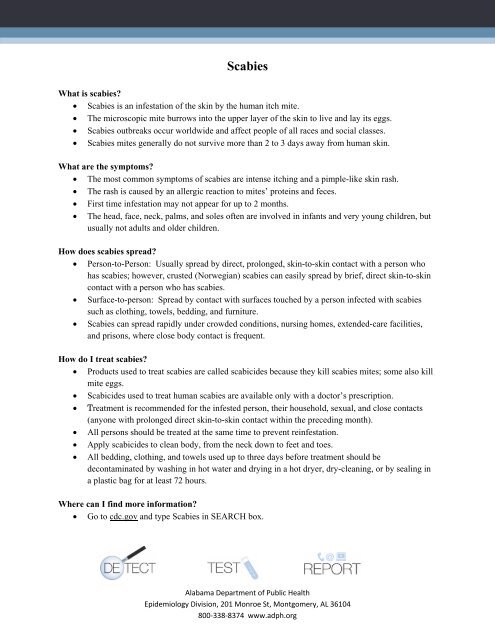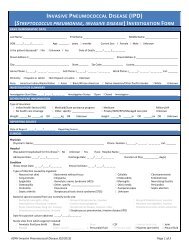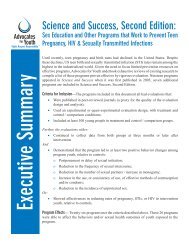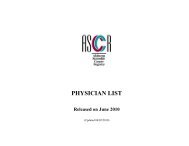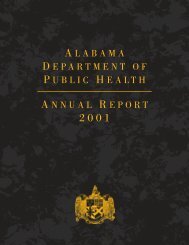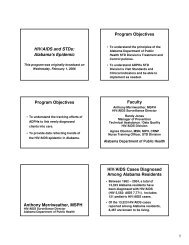Scabies - Alabama Department of Public Health
Scabies - Alabama Department of Public Health
Scabies - Alabama Department of Public Health
Create successful ePaper yourself
Turn your PDF publications into a flip-book with our unique Google optimized e-Paper software.
<strong>Scabies</strong><br />
What is scabies?<br />
• <strong>Scabies</strong> is an infestation <strong>of</strong> the skin by the human itch mite.<br />
• The microscopic mite burrows into the upper layer <strong>of</strong> the skin to live and lay its eggs.<br />
• <strong>Scabies</strong> outbreaks occur worldwide and affect people <strong>of</strong> all races and social classes.<br />
• <strong>Scabies</strong> mites generally do not survive more than 2 to 3 days away from human skin.<br />
What are the symptoms?<br />
• The most common symptoms <strong>of</strong> scabies are intense itching and a pimple-like skin rash.<br />
• The rash is caused by an allergic reaction to mites’ proteins and feces.<br />
• First time infestation may not appear for up to 2 months.<br />
• The head, face, neck, palms, and soles <strong>of</strong>ten are involved in infants and very young children, but<br />
usually not adults and older children.<br />
How does scabies spread?<br />
• Person-to-Person: Usually spread by direct, prolonged, skin-to-skin contact with a person who<br />
has scabies; however, crusted (Norwegian) scabies can easily spread by brief, direct skin-to-skin<br />
contact with a person who has scabies.<br />
• Surface-to-person: Spread by contact with surfaces touched by a person infected with scabies<br />
such as clothing, towels, bedding, and furniture.<br />
• <strong>Scabies</strong> can spread rapidly under crowded conditions, nursing homes, extended-care facilities,<br />
and prisons, where close body contact is frequent.<br />
How do I treat scabies?<br />
• Products used to treat scabies are called scabicides because they kill scabies mites; some also kill<br />
mite eggs.<br />
• Scabicides used to treat human scabies are available only with a doctor’s prescription.<br />
• Treatment is recommended for the infested person, their household, sexual, and close contacts<br />
(anyone with prolonged direct skin-to-skin contact within the preceding month).<br />
• All persons should be treated at the same time to prevent reinfestation.<br />
• Apply scabicides to clean body, from the neck down to feet and toes.<br />
• All bedding, clothing, and towels used up to three days before treatment should be<br />
decontaminated by washing in hot water and drying in a hot dryer, dry-cleaning, or by sealing in<br />
a plastic bag for at least 72 hours.<br />
Where can I find more information?<br />
• Go to cdc.gov and type <strong>Scabies</strong> in SEARCH box.<br />
<strong>Alabama</strong> <strong>Department</strong> <strong>of</strong> <strong>Public</strong> <strong>Health</strong><br />
Epidemiology Division, 201 Monroe St, Montgomery, AL 36104<br />
800‐338‐8374 www.adph.org
<strong>Scabies</strong> Outbreak Institutional Guidelines<br />
<strong>Scabies</strong> outbreaks have occurred among patients, visitors, and staff in institutions such as nursing homes,<br />
long-term care facilities, prisons, and hospitals. A scabies outbreak can occur as a result from a delayed<br />
diagnosis and treatment. The characteristic itching and rash <strong>of</strong> scabies may not be present in debilitated,<br />
immunocompromised, institutionalized, or elderly persons with crusted (Norwegian) scabies.<br />
Recommendations for treating and preventing scabies<br />
• Immediately consult with physician or dermatologist about a definitive diagnosis <strong>of</strong> scabies and<br />
treatment options.<br />
• Obtain skin scraping from suspected persons infected with scabies to be sent to the State laboratory<br />
to be tested for the presence <strong>of</strong> mites, eggs, or mite fecal matter to confirm scabies.<br />
• Once confirmed by lab and physician, begin treatment. This should include the entire body from the<br />
neck down, especially under well-trimmed fingernails. Keep the fingernails trimmed to prevent<br />
secondary skin infections.<br />
• Notify the local health department <strong>of</strong> any scabies outbreak.<br />
• Notify any institutions that may have recently treated persons or staff suspected or confirmed with<br />
scabies.<br />
• Treat all suspected and confirmed cases <strong>of</strong> scabies and prophylactic treat staff, other patients,<br />
visitors, or family members who may have had skin-to-skin contact at the same time to prevent<br />
exposure.<br />
• Avoid direct skin-to-skin contact with persons suspected or confirmed with scabies for at least 8<br />
hours after treatment by implementing strict contact precautions, including handwashing and<br />
personal protective equipment (PPE) such as gowns, gloves, and shoe covers.<br />
• To prevent the spread <strong>of</strong> scabies during treatment, restrict suspected or confirmed people to one<br />
designated area. Limit the number <strong>of</strong> staff exposed to them by assigning one set <strong>of</strong> caretakers.<br />
• Notify transport companies and receiving facilities that the person is suspected or confirmed with<br />
scabies so they can implement infection control measures. Consider a stay-in policy for persons<br />
suspected and confirmed <strong>of</strong> scabies until successfully treated.<br />
• Linens, towels and clothing used by persons suspected and confirmed with scabies must be sealed in<br />
water soluble plastic bags prior to leaving the room, machine-laundered using hot water and hot<br />
dryer cycles, or dry-cleaned. <strong>Scabies</strong> mites will die if exposed to a temperature <strong>of</strong> 122 degrees<br />
Fahrenheit (F) for 10 minutes.<br />
• Bedding, clothing, rugs and furniture used by persons suspected and confirmed with scabies that<br />
cannot be laundered or dry-cleaned, must be sealed in a plastic bag or wrapped in plastic and<br />
removed from human contact for 3-6 days.<br />
• Educate all patients or inmates, staff, visitors, and family members about scabies, how to treat, and<br />
prevent the spread.<br />
• Document names <strong>of</strong> suspected and confirmed persons with demographic information, onset date,<br />
treatment dates, response to treatment, follow-up date, and ordered test and results.<br />
• Screen all new clients and staff entering the facility for scabies.<br />
• If itching is still present after 2 - 4 weeks after treatment, any skin sores become infected, or if new<br />
burrows or pimple-like rash lesions reappear, notify the physician.<br />
<strong>Alabama</strong> <strong>Department</strong> <strong>of</strong> <strong>Public</strong> <strong>Health</strong><br />
Epidemiology Division, 201 Monroe St, Montgomery, AL 36104<br />
800‐338‐8374 www.adph.org


